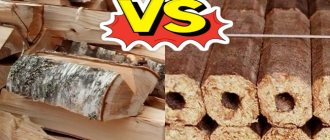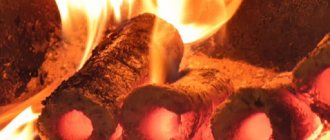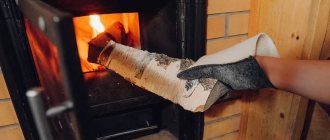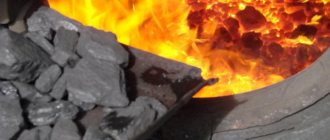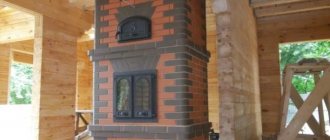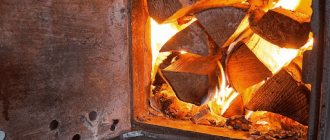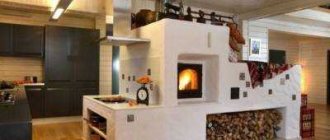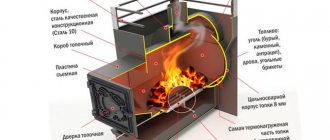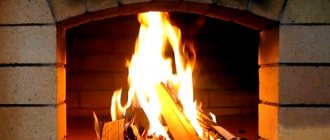Recently, the trend of returning to old traditions, at least in the domestic sphere, has become increasingly clear. Every owner wants to have a stove or fireplace in his home, which he identifies with the hearth. The warmth, coziness and comfort that stoves and fireplaces can give us are incomparable to anything else. In addition, private homes often already have a heating system, so a stove or fireplace is more of a decorative tool designed to bring peace, tranquility and joy.
To light a stove or fireplace, we can use ordinary firewood, or we can resort to innovative fuel. In this article we would like to talk about how to heat a stove with fuel briquettes, a modern alternative to classic firewood.
Smooth burning of eurobriquettes in the oven
How to properly burn with briquettes?
To achieve maximum results, you should properly heat the stove with fuel briquettes.
Sauna stove
To heat a bathhouse, you need fuel, which not only emits a large amount of heat, but also burns out longer. This will ensure a stable temperature for a long time. These are the properties that briquette products have.
When igniting the stove and firing it, you should adhere to the following tips:
- thoroughly clean the stove from ash and other fuel residues from the previous firebox;
- put some wood chips, paper, bark or other flammable materials on the grate;
- then put a small amount of eurowood and light the firebox.
Briquette stacking
Ignition
You should not use a large amount of fuel at one time, as this will lead to maximum heat transfer, which is not required by a sauna stove. It is better to put an average amount, leaving gaps between the briquettes for air blowing.
This type of fuel is very good for use in bathhouses. The aroma of essential oils from environmentally friendly wood materials fills the entire room and has a beneficial effect on the well-being and health of visitors.
Stove for heating a house
It is convenient to use fuel briquettes for the stove in the house. You can light them up and not throw anything else in for a long time. There are two ways to light Eurowood in a home stove:
- The first is similar to igniting fuel in a bathhouse: briquette fuel is placed on dry wood chips or paper. The fire is regulated by blowing.
Briquette stacking - The second method is even simpler: a small batch of firewood is first burned. The heat after them is enough to burn the briquettes. They are packed loosely into the oven for faster burning. If you do not need quick heating, but want a long burning time, pack Eurowood more densely.
Ignition with wood
To heat your home, you can use coal or peat briquettes. They give a high combustion temperature, but also leave a lot of ash in the ash pan.
Ash from burning wood briquettes can be used as fertilizer in any garden plot.
After burning briquettes several times, you will be able to evaluate their effectiveness and find out their consumption. In the future, you can compare the number of briquettes needed and the amount of firewood for heating your home.
Types, characteristics, advantages and disadvantages
The second name for fuel briquettes is Eurowood. Their production uses mechanical impact, extrusion and hydraulic equipment.
In everyday use, fuel briquettes are divided according to their shape into:
round (nestro/nielson)
bricks (roof)
square with hole (pinkey)
According to the type of raw materials used in the production of briquettes, products are divided into:
woody
peat
straw
from the husk
from the shell
Wood fuel briquettes are a classic version of Euro firewood. The main types of raw materials for their production are: sawdust, shavings, branches and other types of wood waste.
The best tree species for making fuel briquettes are birch, oak and pine needles.
Eurowood made from them can be used for combustion in solid fuel stoves of any type. Peat briquettes can only be burned in a special type of firebox. When burned, they emit a lot of soot. The cheapest products are fuel briquettes made from straw.
Expert opinion
Lovkachev Boris Petrovich
Bath master who knows everything about steaming
Peat fuel briquettes have one big drawback - when burning, a large amount of soot is released. Therefore, such briquettes require certain ovens.
The cheapest type of fuel briquettes is straw eurowood. They have a low heat transfer coefficient. When burned, they produce a lot of ash. Rare, but high-quality fuel briquettes are products made from shells. They have a high cost and beautiful combustion. They are most often used for heating in fireplaces.
The highest temperature briquettes are products made from sunflower shells. Fuel briquettes made from husks emit a lot of heat and soot when burning.
Round
Eurofirewood of this type has a cylindrical shape. Products are produced with diameters from 60 to 90 mm and log lengths from 50 to 350 mm. They are made by pressing on high-pressure hydraulic and mechanical presses. Dry crushed wood is used for their production.
Round fuel briquettes with a thickness of at least 80 mm and log lengths from 250 to 350 mm are considered to be of the highest quality. They have a higher cost, but have good heat dissipation due to their high density.
"Bricks"
The standard size of RUF briquettes is 65x95x150 mm. They got their name from the German company RUF, which is a manufacturer of hydraulic presses used in the production of briquettes. The main raw materials for their production are sawdust and wood chips.
To fire sauna stoves, you should not purchase briquettes of this type, which have fine-grained porosity and a white color.
Such Euro firewood is made from waste plywood production. They are colored white by birch dust, which is obtained by sanding plywood. In addition to it, the briquettes contain glue and formaldehyde resins, which release toxic substances when burned.
Pini-kay
The products have the shape of 4 and 6-sided briquettes. They are made by pressing at high temperatures. Eurofirewood of this type has greater density, increased moisture resistance and heat transfer. Standard product dimensions: cross-section – 50x80 mm, length 200-300 mm.
The name of the products was given by the previously existing Austrian company Pini&Kay. It was engaged in the production of screw presses for the production of fuel briquettes, which are still widely used for the production of these types of products in Russia.
In the pini-kei production process, not only pressing technology is used. The surface of the products is fired. This increases the resistance of briquettes to moisture and increases their strength. Pini-kei are premium fuel briquettes and have a high cost.
What stoves can be heated with briquettes?
Briquettes are distinguished by their versatility. They can be used in any type of stoves, including brick ones. They emit about four and a half kcal per kg, which is quite acceptable for a heating device made from refractory bricks. The main advantage of briquettes compared to regular logs is that they burn out several times slower.
This fuel is economical and cheap. Regular logs need to be sawed, chopped, flattened and dried. And Euro firewood does not require lengthy preparation: it is enough to purchase it and store it in a dry room in film or original packaging.
The fact that the fuel burns slowly is a disadvantage for some premises. It will take several hours to warm up the house in winter. The heat from such fuel is much less. And after the combustion of briquettes, the ash has a characteristic pungent odor.
Common Operation Problems
The main problem when operating a buleryan is the release of flammable gases, which cannot burn due to the moisture of the wood and are released in the form of condensate.
To solve all operational problems, it is enough to use exclusively dry firewood, otherwise the released gases will settle on the surface of the pipes and form growths, leading to blockages. Despite the fact that sellers say that you can drown Bulleryan with anything, in reality this is not so. It is best to use firewood and wood products as fuel. This can be a big disadvantage for those who prefer to burn with coal.
Why does Buleryan smoke?
Buleryan may smoke due to the fact that there is no draft or the stove has not been serviced for a long time, i.e. the chimney was not cleaned; similar situations occur if the stove was still heated with wet wood. These problems can be eliminated by mechanically cleaning the pipes with a special metal rod or by cleaning with special chemical briquettes. After cleaning the chimney and if there is draft, smoke will not come out.
It can also smoke due to the fact that the damper is completely closed, i.e. there is simply nowhere for the smoke to escape. As stated in the instructions for heating the stove, the damper should not be closed, only slightly closed.
To prevent smoke from being thrown into the room, it is necessary to follow the rules for installing chimneys. There should be no tall trees or buildings nearby, and the pipe should also rise above the roof and ridge of the roof by at least 500 mm.
Can't melt it
At the beginning of operation, using Buleryan is a pleasure - it does not take up much space, warms the room well, and saves firewood. But, if over time the stove becomes more and more difficult to light, this means that the chimney may be clogged and needs to be cleaned. There are two ways to clean the stove: mechanical (use a special metal rod to break through the build-up that has formed in the chimney), chemical (heat the stove with special brackets, which remove the blockage during combustion).
When installing a stove, proper installation of external chimney pipes is necessary. If the pipes are installed incorrectly - there are hills nearby (trees or buildings), or the pipe does not rise enough above the roof of the house and the ridge, the smoke will not be able to escape through them, but will go into the room. It is impossible to light the stove under such conditions. Check that the chimney pipes are installed correctly.
It is important to read the instructions before starting to use them; they describe in sufficient detail how to heat buleryan.
Other problems
According to user reviews, the main problems with Buleryan stoves are the emission of smoke into the room and the release of carbon monoxide, which is harmful to health. Other problems may arise due to improper operation, use of wet firewood, or failure of the stove. As stated above, you cannot use coal as fuel to avoid burning the walls of the boiler.
At the beginning of use, smoke will be emitted from the paint, but after a few fires this problem will disappear by itself. In addition, external pipes have to be insulated for better heat transfer.
About security
When using Eurowood, you should follow the same safety rules as when burning any other type of fuel. You should not leave the stove unattended, completely clog the firebox, or open the vent too much.
Eurowood takes some time to ignite. Due to this, arbitrary combustion from heat or temperature is excluded if the fuel is near the stove.
Follow safety precautions!
What is better to choose regular firewood or euro?
Fuel briquettes are no different from other products on the market, and they also have both advantages and disadvantages. If we compare briquettes with firewood, the former have the following positive aspects:
- Increased burning time compared to wood. They take 4 times longer to burn completely than regular firewood. Therefore, such briquettes are very economical.
- After combustion of fuel briquettes, a very small amount of ash is formed relative to the original weight - no more than 1%. Firewood is different in this regard - if you heat a stove with it, then after combustion it forms coal, which makes up about 20% of the initial volume of the material. Some owners use the ash obtained after burning Eurowood for their own benefit. This is an excellent fertilizer for the soil. As a result of its application to the site, seedling growth improves due to an increase in potassium content.
- Euro firewood provides more thermal energy - about 2 times.
- Modern fuel briquettes emit heat during almost the entire combustion process. In the case of conventional firewood, the heating power never remains constant and decreases over time. After about 15 minutes the coals are completely extinguished. Euro firewood emit the same amount of heat until it is completely converted into ash, and even when it has turned into coals, it burns for about 1 more hour. This fuel is ideal for those people who often go outdoors with a barbecue.
- If you heat the stove with briquettes, you will not get sparks, smoke or unpleasant odors. Therefore, the use of Euro-firewood does not harm the environment, as well as people who sit next to the heat source.
- The combustion process of Eurowood is not accompanied by the formation of substances hazardous to human health. This is explained by the presence of fungi and mold in ordinary firewood, which are not found in fuel briquettes. Microorganisms cannot withstand high temperatures and die, creating toxic smoke.
- When using Euro firewood, no soot is formed, so the chimney walls remain clean.
- Small sizes of Euro firewood. Thanks to this quality, they can be rationally placed in a small area, saving a lot of free space. They are offered to customers in the form of neatly stacked stacks. In contrast, firewood has different shapes and sizes, so it will not be possible to stack them neatly even if you want to. Everyone is familiar with the situation when firewood is delivered to the customer: it is simply dumped out of the truck onto any free space on the site. Then everything depends entirely on you - you will have to spend more than one hour to move them to the barn and put them in the order you need.
Even though fuel briquettes have a lot of advantages, the main one should be considered efficiency. Although for some buyers other useful qualities of European firewood will be of no small importance. This includes cleanliness and order. In the case of ordinary firewood, which many owners use to heat their stoves, a large amount of dust, chips and other debris is often formed. When using briquettes, the owner solves all these problems at once. However, is it only right to choose briquettes for this reason?
Conclusion
Thanks to modern technologies, we can use alternative fuel - briquettes. These are compressed particles of various materials. The most common briquettes are made from sawdust, but similar products can be purchased from straw, peat or coal.
With the help of fuel briquettes you can heat a bathhouse, a summer house and a private house. Their main advantages are environmental friendliness and high heat transfer at an affordable price. Disadvantages include the long time it takes to ignite the fuel and the pungent smell of ash, which is uncharacteristic of firewood.
Initial data for calculation
Calculation of solid fuel consumption per boiler during the season depends on many parameters: the area of the house and the height of the ceilings, the average temperature in the cold season, the duration of winter, the quality of the thermal insulation of the walls, the heat transfer of the fuel and the efficiency of the equipment.
It will not be possible to take into account all the variables, but we can calculate the average value for different types of fuel so that you can compare and choose the option that is right for you.
Let's take the following initial data:
- Let's take the duration of the cold season as 111 days, from November 27 to March 13.
- The area of the room is 100 square meters.
- The amount of heat to heat 1 square meter is 100 W per hour.
- Accordingly, there are 24 hours in a day and an average of 30 days in a month.
If necessary, you can substitute into the formula the actual area of the house, the duration of the cold season, depending on the region of residence.
Methodology for calculating the amount of fuel for the season
Let's figure out how to calculate the consumption of any type of fuel for a room. First, we will calculate how much heat is needed to heat the entire house per hour. Multiplying by 24, we get the daily value, then multiplying by 30 and 111 days, what is the consumption per month and for the entire heating period.
After this, we calculate the heat transfer of the accepted unit of measurement for each type of solid fuel. By dividing the amount of heat required per month and season by heat transfer, we will see how much of this type of combustible material is needed per month and for the whole year. This will show us how much fuel we need to store for the winter and allow us to compare the efficiency of different devices.
